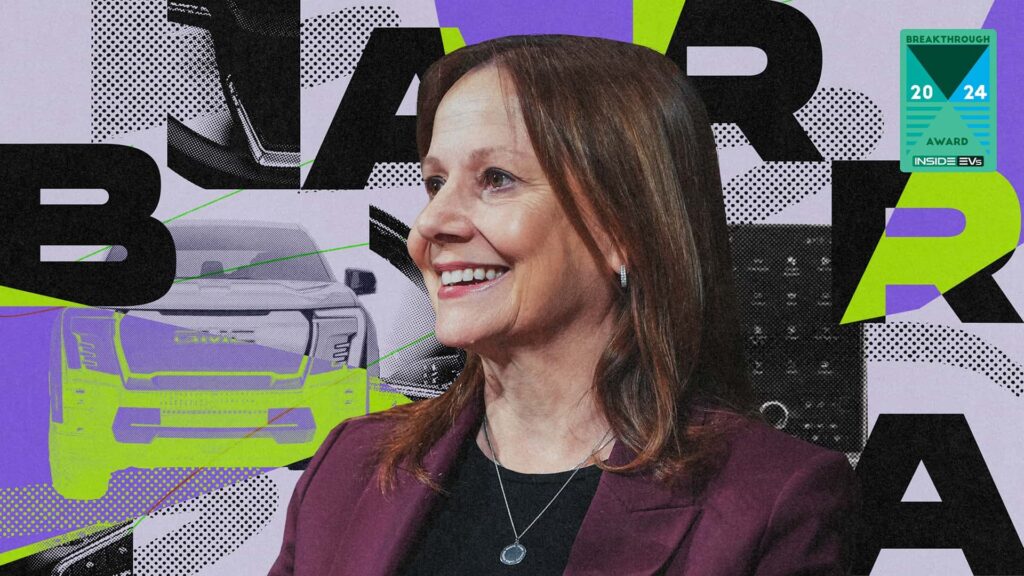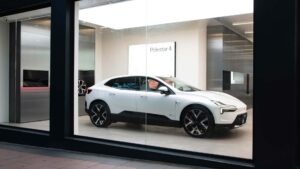
The electric vehicle world is a graveyard of promises. A year ago, it seemed like General Motors might need to pick out a few burial plots of its own there.
The company’s EV battery production plan was way off schedule. Key new electric models kept getting delayed. One of its most important new cars ended the year under a stop-sale order after customers and journalists experienced disastrous software bugs.
Certainly, GM wasn’t alone in looking at the rise of Tesla and China’s electric automakers and saying, “How hard can this be?”, only to get crushed by reality. But adding the zero-emission dreams of America’s largest automaker—and one that once vowed to go all-electric by 2035—to that graveyard felt especially bleak.
Evidently, however, in her 10th year on the job, GM CEO Mary Barra is still up for a good challenge.
(Welcome to The Breakthrough Awards, InsideEVs’ year-end awards program recognizing the EVs, people and technologies that are paving the way for our clean energy transition. Read about the awards and the other contenders below.)
In less than 12 months, GM has turned things around to the point where it’s a rare bright spot in the EV world, turning out new models all the time and offering some of the best—and only—truly affordable electric options on the market. Under Barra’s leadership, GM executed an electric turnaround that may be taught in business schools someday. That took some doing, and it’s why she is the InsideEVs’ Breakthrough Awards’ Person Of The Year for 2024.
Business schools also teach stupid things, like how short-term shareholder returns aren’t your most important concern but your only one. Instead, we gave Barra this award for what GM has done for consumers, above all else: the Equinox EV in particular is the affordable, mainstream electric option that American families have been clamoring for. GM, in 2024, helped break the electric car out of the “high-end spaceship” paradigm it’s been stuck in way too long.

GM CEO Mary Barra with the 2024 Chevrolet Equinox EV
This transformation finally seems to be happening across the board. GM has other great affordable options like the Blazer EV and forthcoming reborn Bolt EUV (which we have little reason to think isn’t on track) and it also offers a growing range of electric trucks, high-end Cadillacs, even a three-row crossover. After 2023’s headaches, Barra certainly delivered on her promise to make 2024 a “year of execution.”

Photo by: General Motors
Yet even a good CEO can only do so much herself. It’d be a mistake to say that Barra alone rolled up her sleeves, dug in and cracked the code for fixing all those problems; she is not the person that Elon Musk pretends to be online.
That’s also why she deserves credit for acknowledging, and addressing, one of GM’s greatest historic weaknesses: its insularity. For the longest time, GM’s prevailing attitude was that everything produced within the company was better than without, which is why its roster of engineers and managers is so dominated by cradle-to-grave lifers. But in a world defined by batteries and software, some fresh perspectives are necessary right now.
GM brought on Baris Cetinok, a longtime veteran of the tech space with tours at Apple, Microsoft and Amazon, to lead software efforts. It hired former Tesla execs Kurt Kelty and JP Clausen to oversee battery operations and global manufacturing, respectively. There are many more examples of high-profile hires from Tesla, Apple, Google, Lucid and others. That’s a big deal for the General, a company long known for refusing to look outside of itself for answers.
None of that is meant to diminish the considerable talent within GM, of course. It remains one of the greatest engineering firms in the world, and this turnaround could not have happened without its existing talent’s vast carmaking know-how. We’ve spoken to countless engineers and product planners who have worked at GM for decades and have not only been bitten by the electric “bug,” but are determined to win the future. But it takes a leader who can see how all of those components can work together and make sure it happens, and Barra has done that.

It continues to impress us that GM’s reversal came at the hands of a CEO who’s been on the job for almost 11 years and is a company “lifer” herself. Maybe it’s because she put herself through college working on a GM assembly line and rose through the ranks overseeing global manufacturing, personnel and product development; she’s always been a person who can see how systems should fit together. Barra has been a beacon in countless other ways, including as one of the most powerful women leaders in the world. And besides things like sales and profits and new model launches, there’s the stuff that deserves more attention than it gets, like the innovations with the hands-free driving aid Super Cruise or GM Energy’s efforts with charging and electric home power.
We looked closely at the competitive landscape for this award. The Hyundai Motor Group and its leadership came close, as its long-planned commitment to EVs is also paying dividends better than most, but ultimately we voted in favor of GM’s turnaround. By contrast, Ford, an early mover in the EV space and a true innovator at things like charging access, continues to be buried under battery and manufacturing costs. Volkswagen, with the foresight to build EVs in America, should be a leader in most markets but it’s buried in Europe’s carmaking crisis instead. Startups like Lucid and Rivian continue to be impressive in different ways and we see a future where their leadership could also win such an award, but their long-term stability is far from guaranteed. (As for Tesla, it’s unclear who’s even running that show anymore. It has drifted away from whatever stated mission it once had and it is debatable how much time its CEO has actually spent running it this year.)
Granted, GM is not out of the woods. The company’s weaknesses and ongoing setbacks were weighed carefully by our judges. GM has still dialed back some of its EV plans and is, at the end of the day, still powered by gas truck profits. We also certainly do not agree with every decision made under Barra’s watch. GM, while profitable, has still done multiple rounds of layoffs this year and last. The decision to kill off the affordable Chevrolet Bolt, however temporary, was a strategic misfire that went against what most Americans are seeking from an EV. We do not see a path to victory in the public eye for the decision not to offer features like Apple CarPlay and Android Auto. We also questioned GM’s ability to truly move at lightning speed like its competitors. Its inability to offer any plug-in hybrids—a technology it pioneered and then abandoned, and under Barra’s watch—until 2027 may be a troubling sign for its agility.

Photo by: Cadillac
GM CEO Mary Barra at the 2024 Cadillac Celestiq reveal
And as is the nature of a bet, not all of them pay off. As we saw just last week, GM still has its work cut out in China, let alone for the day when companies like BYD and Xpeng and Nio arrive on GM’s home turf. The evening before this story was published, Barra announced GM was throwing in the towel on its Cruise Robotaxi service. As ambitious as that bet was, only time will tell if GM got anything out of it besides more than $10 billion in losses.
That’s the game these days. For an industry as entrenched as this one, nothing in this new future is promised and promises mean nothing.
But GM, under Barra especially, seems to have a collective talent for getting up and hitting back twice as hard when it’s knocked down. If it can keep that spirit up, we expect many more breakthroughs to come.
Contact the author: patrick.george@insideevs.com



